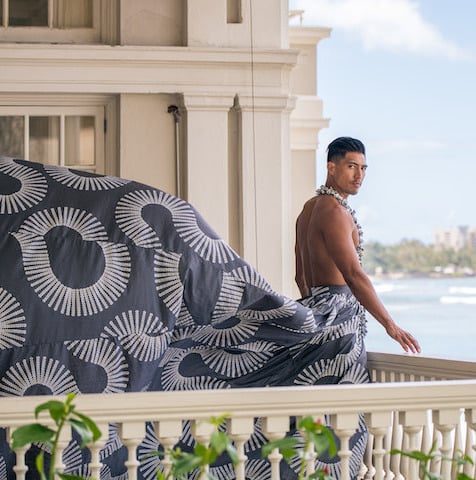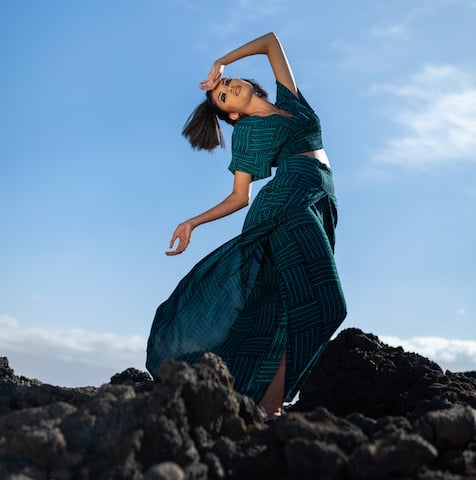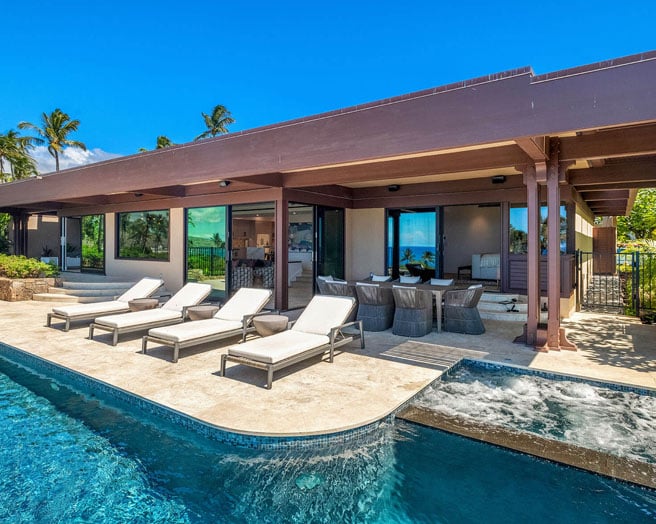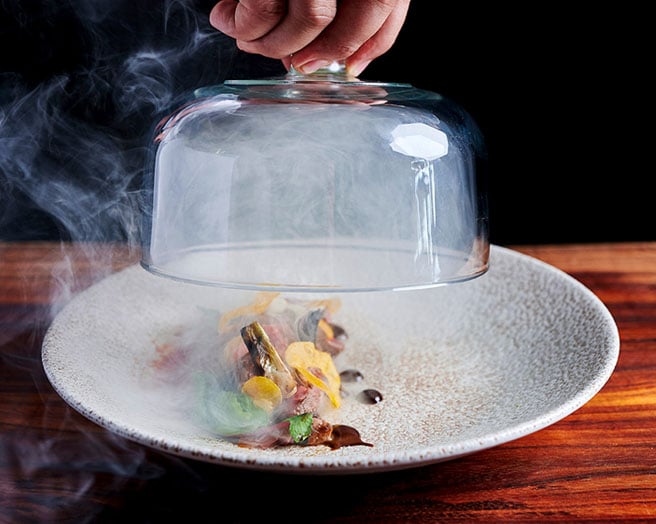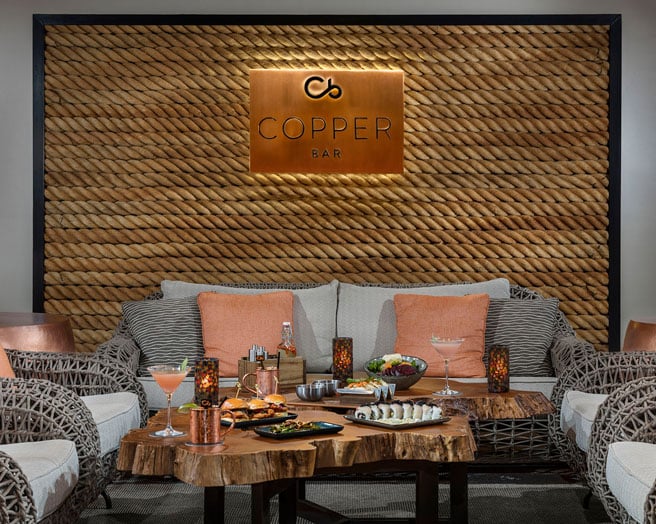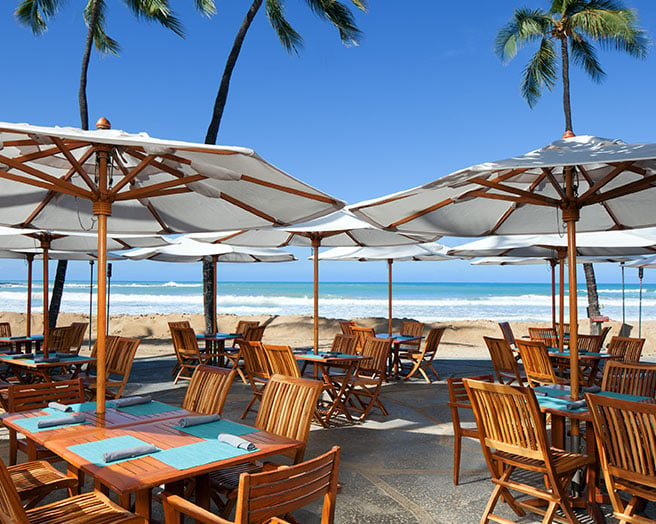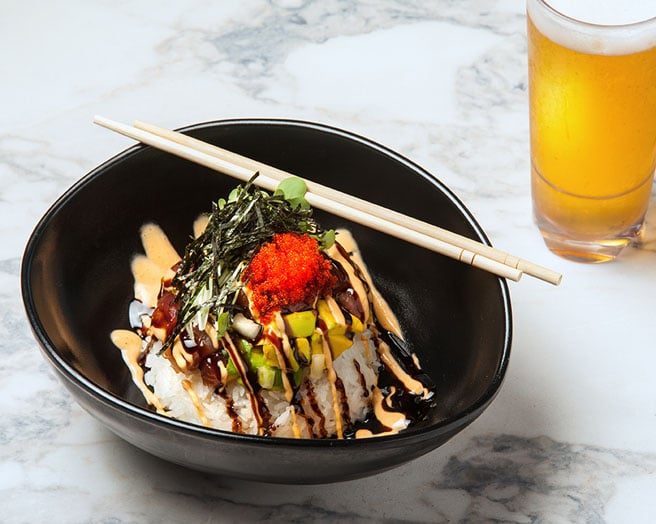Culture Conscious
By Sara Stover
Manaola Yap is choreographing Hālau Manaola, the dancers poised on an open-air kahua hula (dance platform) in the shadow of Maunakea. He’s donning a shirt from his own collection, adorned with palapalai ferns as green as the fields stretching out to the mountain’s foothills.
“My designs are wearable experiences that bring nature’s inspiration to the modern world. The palapalai fern, for instance, is prized among hula dancers as an embodiment of Laka, the goddess of hula,” says Manaola of the indigenous plant, which can be found at the base of native forests. “This design captures the beauty of the forest realm. As the palapalai move gracefully in the slightest of winds, so too the dancer moves with the elemental movements of nature.”
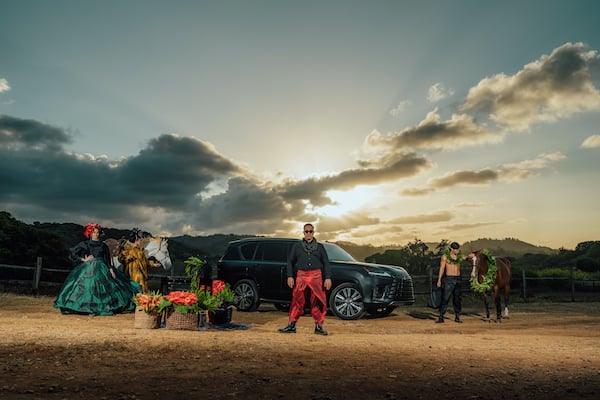
Born and raised in the Kohala region of Hawai‘i Island, Manaola is a cultural practitioner acclaimed for translating Hawaiʻi’s natural beauty and powerful spirituality into prints. The self-taught designer is also the first Native Hawaiian designer to present an entire runway line of cultural fashion at New York Fashion Week.
“I come from a family of musicians and cultural practitioners. Hula and the associated arts — costume, lei making, implements, percussion, chanting — are very integral parts of our traditions,” says Manaola, whose ancestors were hula practitioners and artisans of traditional Hawaiian dyes and textiles for generations before Western contact. An entertainer, hula dancer, award-winning kumu hula (hula teacher), musician and Merrie Monarch Festival judge for several years, his mother, Kumu Nani Lim Yap, is part of the renowned Lim musical ʻohana.
“Our Kohala hula heritage has been passed down for generations through our late grandmother, with roots that pre-date Kamehameha I,” Manaola adds. It’s a legacy that Nani, the kumu hula of Hālau, shared with her son by teaching Manaola the art and technique of costume research, design and styling through his hula hālau (hula school) studies.
A Kung Fu and Chinese Lion Dance instructor and lineal descendant of the Tong Wo Society (which built the first Chinese gathering house on Hawaiʻi Island), Manaola’s late father, Edward Yap, also cultivated his love of cultural artistry. Manaola grew up performing the traditional Lion Dance as a Lunar New Year blessing throughout Hawaiʻi with Big Island Shaolin Arts, led by Edward.
Raised in this incubator of creativity, Manaola won the title of Master Keiki Hula for all three islands at the age of 11, as well as the Hula O Nā Keiki Competition, Hula Leʻa Competition and the Queen Liliʻuokalani Keiki Hula Competition. After graduating from Parker School, he went on to represent Hawaiʻi at the 1992 World Exposition in Spain and the 2005 World Exposition in Japan.
“Hawaiian culture is shared through osmosis. Hula lets me live the culture. Language, rituals, preparation of food — you don’t even realize that you’re gaining this knowledge and learning the importance of passing it all on. And that’s all part of the intentional design,” says Manaola of the upbringing, experiences and transferred knowledge that opened doors for him. “This launched me off on an intense spiritual and physical journey to discover and understand my past so that I might honor it in the future.”
It was this journey that sparked Manaola’s interest in design, textiles and fashion, leading him to research Hawaiʻi’s history of pre- and post-Western-contact fashion while simultaneously developing his skills as a hula practitioner and deepening his roots in an ancestral, volcanic soil. From it, grew an inspired idea to translate the beauty of Hawaiʻi and the spirituality of its culture into an artistic language that could be shared with and understood by the whole 21st-century world: fashion. This vision blossomed into the prolific fashion label MANAOLA.
“I was taught that mana is ‘empowerment you gain through experiences’ and ola is ‘life.’ ‘Manaola’ to me is the purest form of energy. Print design is a channel for the great mana of our natural surroundings, and I wanted to create lifestyle products for people with that same energy. MANAOLA was the perfect name for the brand,” says Manaola, who believes this benevolent energy will be transferred to the wearer of the clothes he designs. And while launching his brand was not without its challenges, Manaola transformed even those into unforgettable patterns.
“Making a small business take off is hard, especially in Honolulu. It’s not a city that is set up to help small businesses succeed. One day, I went to the ocean, [feeling] overwhelmed,” Manaola recalls. “It was then that I saw two ʻiwa birds and realized that I was at Kaiona Beach Park. Kaiona is the goddess who helps anyone who lost their way by sending ʻiwa to guide them. In modern times, the birds are a symbol of carrying on, which I recognize in several of my prints.”
Manaola overcame these initial obstacles and introduced his first collection of hand-dyed, hand-printed canvas accessories and pillows in 2014. He then released his first ready-to-wear collection at the 2015 Merrie Monarch Festival and launched his first apparel collection for men and women in two independent fashion shows at the Honolulu Design Center in 2015. As a native hula practitioner, nature’s elements have continued to serve as a steadfast guide, shaping Manaola’s intentions, informing his care for the ‘āina, and providing spiritual strength and artistic inspiration for patterns like the Niho Kū. Translated to “standing shark tooth,” Niho Kū is a set of prints based on a traditional design and inspired by both the lava formations jutting out of Kawaihae Harbor and the representation of the harbor’s mano (sharks).
Moved by Hawaiian ideologies that often refer to important animals, plants, places or stories, Manaola brings the art of ʻohe kāpala into modern designs. Dating back over 1,000 years to the early Polynesian voyagers who migrated to Hawaiʻi, ‘ohe kāpala is a Hawaiian method of kāpala (stamping) cloth with ‘ohe (bamboo). By gathering the native variety of ‘ohe by hand, unaided by machine tools, Manaola honors the art of his ancestors.
“Sometimes when you canoe, you can see to the bottom where there are little coral polyps. Their perforations inspired me to create the akoʻakoʻa print or coral formations,” says Manaloa, who stamps akoʻakoʻa and other prints after hand-carving his intricate designs onto bamboo laths. The prints are then digitized onto original silhouettes and transferred onto high-quality fabrics used to create clothing alive with the power of coral and other elements of nature. “I draw on my traditional roots in our Indigenous way of storytelling and translate that into the medium of Hawaiian culture through fashion, which is relevant.”
It isn’t hard to imagine how the connectivity of Manaola’s stories reached the Oxford Fashion Studio (OFS), resulting in an invitation to participate in his own fashion show during New York Fashion Week. Of the five shows OFS put on in 2017, Manaola was one of only two designers to have their own runway show — an exclusive, 39-piece show at that. As the first Native Hawaiian designer to present a line of authentic cultural fashion, Manaola integrated oli (chanting) and traditional hula into his show.
Since his debut at Fashion Week, Manaola has continued to infuse ancient power into his elegant designs while empowering the next generation of storytellers through the non-profit Hale Kua. Led by Manaola and CEO Zachary Pang, Hale Kua’s Business Incubator Program inspires the entrepreneurial spirit in Indigenous creatives by guiding participants through inspiration, translation, creation, business plan and business pitch. The ten-month mentorship begins with a week-long retreat on Hawaiʻi Island, followed by weekly workshops and in-person events intended to preserve and elevate Hawaiʻi’s native culture and people.
“Participants have the unique opportunity to step into my creative space. Immersed in culture, ritual and ceremony, they explore the building blocks of culturally based business rooted in Hawaiian values and create an affinity with nature and the environment, ultimately empowering them to receive inspiration and translate it through art,” says Manaola, emphasizing the importance of perpetuating Indigenous cultures and traditions through art, as well as protecting the intellectual property rights of Native Hawaiian creatives, even in the world of fashion.
In 2021, Italian fashion brand REDValentino released images on its social media of a new design that featured the Native Hawaiian ʻulu (breadfruit) quilting pattern without acknowledging its origins, fueling a controversy. REDValentino reached out to the Office of Hawaiian Affairs to redeem itself, which eventually resulted in an ongoing collaboration with three Hawaiian designers, including Manaola.
“It’s important for us to not just take control of our own narratives as Native Hawaiians, but also to uphold the spirit of Aloha when people want to make things right. Aloha is the exchange of breath that can happen anywhere, and the key to being the best we can be,” says Manaola, who pays homage to Haumea and the ‘ulu through his Nanaka print, which is derived from the ʻulu’s hull. “In Hawaiʻi, the ‘ulu tree is revered as the embodiment of Haumea, the goddess of fertility. The Nanaka print encourages abundance and growth for those who wear it.”
In June of 2024, Manaola shared Indigenous culture through the medium of fashion on a world platform when his sculptural dress, the Hulu Nēnē, was displayed at the Pitt Rivers Museum Galleries in Oxford, England. Meaning “Hawaiian goose feathers,” the installation was presented at the museum’s special exhibition “Hawai‘i: Ma uka to Ma kai.”
“The print on this gown represents a repetitious pattern. In Hawaiian artistic thought, these patterns emulate nature and create a powerful symmetry or a sacred geometry that touches our spiritual eyes, no matter our culture,” Manaola says, pointing out that the repetition in Nēnē feathers depicts the separation of children being weaned from their parents. “It is a print of independence and courage for our youth to walk on their own and embrace their own greatness. For me, it also represents a mother’s love and vigilance in protecting her babies from harm.”
